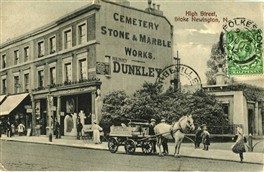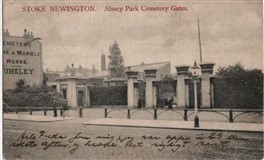219 Stoke Newington High Street N16 0LH (adj. Abney Park Cemetery)

217 Stoke Newington Hight St
courtest @HistoryofStokey (Twitter)

Entrance to Abney Park Cemetery
courtest @HistoryofStokey (Twitter)
219 Stoke Newington High Street
2016/0254 - 18 May 2016
2016/0254 FULL PLANNING PERMISSION Erection of two-storey roof extension in association of the use of the property as a retail/office use (sui generis).
At the time of consultation the application description and application documents described a two-storey extension plus mansard. In the Hackney Society's direct correspondence with the author of the Heritage Statement, David Laverick, it was claimed that the applicant had subsequently amended the application to remove the mansard, plus a later corrected Heritage Statement.
Revised drawings (though not a revised heritage statement) were only uploaded to the Council's website on 11 May and the description was updated after that. Although the Hackney Society has advised some consultees on the revision, it should be borne in mind that many of the consultees have been under the misapprehension that a mansard is proposed. As a result, responses may not fully reflect the strength of feeling on aspects of the proposal other than the mansard. If the Council is minded to grant consent, it must first re-consult on the revised proposal on this sensitive site.
For the avoidance of doubt, we object to the mansard principally on the grounds that it would harm the unity and significance of the three storey terrace, identified as being of Townscape merit and is of an unsympathetic design. It would be an obtrusive development that would interrupt the unbroken roofline of the terrace. Additionally it severely impacts the character and setting of the Gd II listed entrance to Abney Park Cemetery by being a distracting overdevelopment in this context and by being harmful to the wider character and appearance of the Stoke Newington Conservation Area.
The rest of these observations consider the application as revised - without the mansard.
Early C20 photographs show the site surrounded entirely by a wrought iron railing and vegetation at ground floor level filling the plot up to the terrace flank wall (number 217) and the east wall of the South Lodge.
As early as 1912, the then end-of-terrace 217 Stoke Newington Church Street was occupied by Henry Dunkley, a stone and marble mason. The flank wall of the three storey terrace is rendered and in counter-relief is a large scale advertisement for Dunkley's stone works. This advertisement is still visible today. Though regular overpainting has diminished its contrast significantly, this is easily reversed. This 'ghost sign', constructed in counter-relief, rather than painted, is not ephemera, but is part of the fabric of the terrace and a historical reminder of the masonry works. A body of Dunkley's work can be seen in the monuments of the adjacent Cemetery. The sign alone is a heritage asset and its significance needs to be addressed but is omitted from the applicant's Heritage Statement.
The Cemetery gates and Lodges were first listed as Grade II in February 1975. The listing makes no reference to the affixed 219 Stoke Newington High Street. The listing does refer to a "stuccoed extension" to the South Lodge but this is the office extension to the west. However other evidence suggests 219 predates listing.
The building at 219 is well worn in a photograph in 1977 and there is an apparent building line in OS maps dated 1972 (Land Registry Title Plan NGL421543). Anecdotal evidence suggest it was built in the 50s or 60s by the stonemason who then occupied 217 Stoke Newington High Street. No doubt planning records or archives could confirm the origins of 219 Stoke Newington High Street and this must to be addressed in the Heritage Statement before consent is granted.
Notwithstanding the omission we can say the mid-late C20 single storey building at 219 is a copy of the Victorian-built South Lodge and directly extends it, covering a portion of the South Lodge's once external east wall and primary frontage. It has been constructed in the same Egyptian Revival style and in a similar palette to the ashlar stone of the South Lodge but in considerably inferior materials. Were it to be proposed today, it could be said that the extension harms the character, significance and setting of the Grade II listed South Lodge, not least by joining the Lodge to the three storey terrace. As can be seen from earlier photographs, the significant set back and gap between the terrace and the South Lodge makes the latter a coherent and balanced part of the Egyptian Revival entrance to Abney Park Cemetery. It was no doubt a reflection of attitudes and policy of the time that this eastern extension at 219 was built (and presumably permitted) on the basis that it would be a (arguably) convincing copy of the Victorian-built, Egyptian Revival South Lodge; crucially at the same height and carrying forward the pronounced external coved cornice, flat roof and tone of the Lodge. As a result, notwithstanding the physical connection, inferior materials and some later, unsympathetic window alterations, 219 reads clearly as part of the Lodge and not of the terrace.
The current proposal seeks to build on top of the 20C copy Egyptian Revival building at 219 without significantly altering its facades. Herein lies the greatest problem with the proposal. By creating a pastiche of the adjacent late Victorian terrace, at the first and second floor but retaining the pastiche Egyptian copy building at the ground floor, we have pastiche upon pastiche upon pastiche. A Frankenstein's monster of parts crudely cobbled together, having no authenticity or integrity. The resultant appearance would significantly detract from the character and significance of the Grade II listed entrance gates and the South Lodge in particular. It would clearly harm the integrity and unity of the undesignated terrace (being of Townscape Merit) and the character of the Stoke Newington Conservation Area.
The effect of the scale and mass of the extension (without mansard) is more finely balanced. Built up to two storeys, and ignoring the clear design issues above, an argument could be made that this detracts from the South Lodge minimally in comparison to the harm done to the setting by the C20 extension extant at 219. An increase in height may even be said to mitigate the harm (from some views) caused by the former shoe factory building at Wilmer Place which is currently being reclad, and sits prominently behind the South Lodge. However such an extension (if properly designed) reinforces the bogus C20 connection between the South Lodge and the terrace - and this is not necessarily something to be encouraged. At least not so crudely.
The question remains as to whether a careful, coherent, and detailed proposal, might be an opportunity to achieve the applicant's aim without causing as much harm as currently proposed. An entirely new building (that demolishes the C20 copy building) could be more contemporary in character and incorporate a properly designed side elevation facing the forecourt rather than a blank ‘end of terrace’ as at present. A new shop front could open out onto the forecourt (if the Trust and Council were in agreement) and activate and enliven that space. The junction of any new building with the South Lodge would be critical to the design and would involve a slightly smaller building footprint than at present to allow the South Lodge to breathe and to better reveal the sloping nature of the walls of the Lodge. If well designed and executed such a proposal would be an improvement on what is there at present and a positive enhancement that would also allow the applicant to make better use of the floorspace by creating a coherent building with a single, well-placed stairwell.
In any scheme of this scale some harm is inevitable. Following the approach established by the High Court in Barnwell Manor, we must begin with a strong presumption against development where any harm to a heritage asset is identified. It falls to determine if this can be overcome by the purported benefits of the scheme.
The benefits of the scheme as proposed are thin. Constrained by the footprint of the site and with an awkward layout, the additional office space is scant benefit against this strong presumption against development and clear harm.
For all of the reasons above, and in particularly in view of the fact that the scheme would have to be redesigned from the ground floor up to begin to be acceptable, we strongly recommend refusal of the application, and invite the applicant to consider an alternative approach as outlined.
If the Council is minded to approve the scheme it should be subject to the following conditions, and where appropriate, to be discharged before development is begun:
- A heritage assessment of the significance of the relief 'Dunkley' signage on the flank wall of 217 High Street.
- A method statement describing how the sign might be preserved or preferably incorporated in to any proposed building works to better reveal it to occupants.
- A heritage assessment of the history of the extant twentieth century extension to the South Lodge.
- Detailed designs of the north and east facades and of the 'bridge' between the original South Lodge and 219 Stoke Newington High Street.
- Detailed shopfront design and advertising consent.
- A "no signage" condition on any addition advertisements - particularly on the northern wall.
- A listed building consent application in relation to the works abutting the South Lodge.
In addition the Council should ensure the relevant heritage and neighbour consultees are directly invited and encouraged to consider the application and given due time to do so. These include Historic England, The Victorian Society, London Parks & Gardens Trust, Abney Park Trust, and Abney Park Users' Group.
This page was added on 18/05/2016.